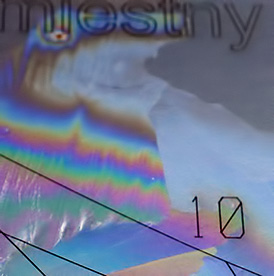Atmospheric
Optics
Horologiis frigore, tempus itineribus?
Morning frost on a sundial face pictured by Daniela Rapav� at Observatory Rimavsk� Sobota, Slovakia.
All images ©Daniela Rapav�, shown with permission
Birefringence or thin film interference?
Thin film interference across ice plates or trapped water layers gives weak colours.
Birefringence is another effect. The atomic structure of ice has asymmetry and light is thus refracted differently depending on its polarization � birefringence. The birefringence refraction is wavelength sensitive and ice seen under polarised light can show colours. Daniela Rapava used a polarizing filter.
I asked Dieter Zawischa (See his Origins of Colour website) what he thought..
" I see a horizontal polished metal plate covered by a thin layer of ice. The scene is in shadow [see below], so it is essentially illuminated by the [polarized] blue sky.
Now look at this cropped detail:

In the upper right corner, there is no ice. At the rim, the ice is very thin, its thickness increases as one proceeds downwards.
Most probably, there is no noticeable change in thickness at the border between the two crystallites in the middle of the cropped image, but clearly the orientation of the crystal axes changes. If the colour bands were due to thin film interference, the colours should be the same in both single crystals.
I think that the ice is much too thick to show thin film interference and that all the colours are due to the birefringence of the ice."
Ice crystals in the lower images are smaller. The temperature was -4 Celsius compared to -1 at top. Temperature history and humidity also influences frost crystal size.
The dial face is mostly shaded from the morning sun.









